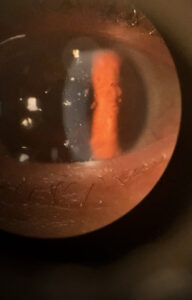 Dos and don’ts of using and coding for amniotic membranes.
Dos and don’ts of using and coding for amniotic membranes.
By Mark K. Davis, OD
Oct. 18, 2023
Perhaps one of the greatest developments in the optometric field, in my humble opinion and during my time, has been the amniotic membrane. Its healing power is truly remarkable. The usefulness of this innovation is not in question. The question is how to code for use of it, so you can correctly document patient visits and get paid.
What Are Amniotic Membranes Used For?
Here is a brief history of the development of the amniotic membrane:
Amniotic membrane (AM) has been used in clinical medicine for approximately 100 years. It has had a slow beginning in clinical use, but over the past 50 years has grown to involve multiple fields of surgery and medicine. Starting from use as a skin substitute to uses in ophthalmic surgery, and now with uses in wound care, orthopedics, and various other disciplines, AM has shown many regenerative and healing properties. Its anti-inflammatory, anti-scarring, and other properties, contribute to its widespread use. AM comes in many different products to promote anti-adhesion processes and decrease inflammation. It is becoming increasingly available throughout the world.–R.M. Jay, J.P. Huish and J.H. Wray, ScienceDirect
As you may know, amniotic membranes come in two forms, cryopreserved and dehydrated tissue. Each has its specific use. Membranes can be used to treat recalcitrant dry eye, recurrent corneal erosion, mechanical injury, bullous or band keratopathy, chemical burns, epithelial basement membrane dystrophy, Stevens-Johnson syndrome, nuerotrophic corneal ulcers and much more.
In Texas, when amniotic membranes first became commercially available, the Texas Ophthalmological Association challenged optometry on being able to use the membranes. Thankfully, the Texas Optometry Board stood up to them and said that the use of amniotic membranes was within our scope of practice and our education. Also, the application of the membrane on the eye was no harder than applying a contact lens to the eye, which we all have much experience with.
How Do I Code & Bill for Amniotic Membranes?
Let’s look at how to code and bill for amniotic membranes. According to the CPT Manual, this is a surgical procedure (i.e. in the 60,000 codes):
CPT 65778
-
- Placement of amniotic membrane on ocular surface without sutures
- Reimbursement already includes office visit on same day
- Global period is zero days, meaning that you can charge for an office visit the next day
- Reimbursement for the supply of the amniotic membrane is not allowed, as it’s bundled into the reimbursement for the procedure itself, so providers cannot bill for HCPCS code V2790 (amniotic membrane for surgical reconstruction, per procedure)
- Also append the code with the modifier RT or LT to designate which eye was involved
In Texas, our Medicare carrier is Novitas. Here are the current reimbursement rates:
Participating Provider $1,367.62
Non-Participating Provider $1,299.24
Limiting Charge Amount $1,494.13
ROI of Amniotic Membranes
The cost of amniotic membranes can range from approximately $200 – $600, depending on how many you purchase at one time. Given that, it is not a bad return on investment. In my opinion, optometry sometimes only thinks in terms of materials. We need to remember, we are doctors and are trained to use our skills and knowledge to treat the patient and make them better. Placing the amniotic membrane on a patient’s eye does take skill, especially with a squeamish patient or if you have dropped a membrane (I have!). Our knowledge is important in knowing which conditions will respond to the treatment with amniotic membranes.
Other Articles to Explore
But Don’t Overdo It
Since the reimbursement is very good for the amniotic membranes, doctors may get caught up in the dollars and use the membranes for almost anything and everything. This is called over-utilization. It can be interpreted as Fraud or Abuse in many cases. Over-utilization by some nefarious individuals causes the reimbursements to plummet.
HERE is an excellent article on over-utilization and how it relates to the medical care system in the U.S.
ROB Professional Editor Laurie Sorrenson, OD, FAAO, and I teach Practice Management to the fourth-year optometry students at the University of Houston College of Optometry. At the beginning of each school year, I ask our good friend Joe DeLoach, OD, to give me updates on Fraud and Abuse cases going on around the country. Here is how Dr. DeLoach described one case that involved an optometrist’s use of amniotic membranes:
“California OD – $1.1M return of money and fines and expelled from Medicare for amniotic membranes (single OD filed for 1,200 membranes in 2019 – was settled in 2021. If you don’t already, you might also tell them [your students] that CMS is like the IRS…filing bankruptcy like this OD tried does not get rid of government obligations.”
HERE is a link to the actual case at the Department of Justice.
So. in closing, let me say once again that amniotic membranes are a wonderful addition to our armamentarium to treat eye disease and conditions. We must use them appropriately and judiciously.
Happy coding!
 Mark K. Davis, OD, is a Therapeutic Optometrist and Optometric Glaucoma Specialist, Diplomate, American Board of Optometry, Adjunct Assistant Professor, University of Houston College of Optometry and Chief of Optometry, 147th Medical Group. He is Lt Col, Texas Air National Guard, Ellington Field JRB, Houston, Texas.
Mark K. Davis, OD, is a Therapeutic Optometrist and Optometric Glaucoma Specialist, Diplomate, American Board of Optometry, Adjunct Assistant Professor, University of Houston College of Optometry and Chief of Optometry, 147th Medical Group. He is Lt Col, Texas Air National Guard, Ellington Field JRB, Houston, Texas.

























